Don't wanna be here? Send us removal request.
Text
Sunday 9 February
The big storm over the Atlantic, Ciara, had been announced and it was now to hit Ireland and Britain big time as well as later other parts of Western Europe, Belgium, Germany, the Netherlands etc. In any case Wulf, one of the tutors, had to get up and leave really early, his flight to Manchester hadn’t been cancelled yet. However, it took him a really long time to get home, there were delays, trains cancelled in the UK, terrible flooding and effects of the storm. Sam, another tutor, who was scheduled to leave later in the afternoon for London was confronted at the airport with eventually a cancelled flight (one of many). He had to stay in Helsinki until he got home after the storm died down following Tuesday evening.
Ausra, the Lithuanian tutor, left with her students to Vilnius on schedule in the afternoon, no storm warning or cancellations in the Baltic area.
• • • • •
Reflecting on this third installment of the CIRRUS project series in Helsinki, what have we learned?
The three main countries participating were Lithuania, Iceland and Finland (the workshops took place in that order), but students and tutors came from 16 different countries or regions. Therefore these projects had a very international feel — almost like a small ‘united nations’.
However, it is interesting to see how each time the location of this project had an effect on the outcome of it. There were some constants of course, e.g., the time of year, early February, the Northern latitudes, the shortness of daylight and the immediate presence of nature.
Please take note that in each of these three countries a very unique language was spoken among a relatively small group of people, i.e., Lithuanian, Finnish, and Icelandic, which also gave it a particular flavor. Obviously working with so many people from all over the world, English was used for communicating, but still, one could see that each language, each location, was leaving its own mark on the projects and concepts. In particular as many concepts were digging into sometimes local narratives and (sub)cultures.
The gaming aspect then added new perspectives. Game design and gamification are excellent problem solving tools and means of connecting people and addressing meaningful issues. And even more than in previous workshops, aspects like social communication, sustainability and responsibility were more present in all of the ideas that were developed in the Aalto University workshop.
As a closing thought, after these three initial pioneering workshops, we are of course immensely grateful for the opportunity that was being offered to us, to research and explore this. The workshops reinforce that the learning is very much for institutes, students and alike. However, it would be of great interest to all parties involved, i.e., sponsors as well as participating schools and organizations, if this could lead to more in depth follow-up projects. We conclude that this is not an ending, but we are on the verge of a new beginning.
1 note
·
View note
Text
Saturday 8 February
After a restful night of sleep (for some), the workshop participants were free to do their own things, to see exhibitions and visit places. In the evening, tutors Tarja, Ausra, Wulf and Lode went to the Caisa Cultural Centre for a concert of Finnish-Senegalese band Hasse Walli & Asamaan, led by a Finnish musician Hasse Walli. It was a great concert of world music, though at times there were complaints of feedback from the band leader as the sound balance wasn’t taken care of properly.
1 note
·
View note
Photo







Group 3 / Ada, Sylvia and Gintare: “THE PROJECT UNDERGROUND”
This group asked to be the last in order to finish a video rendering. The presented concept raises awareness on whales. It is a participatory activist game in Helsinki metro stations where passengers will need to take action in saving a whale that is projected on a ceiling. Goal is to help the “virtual” whale to stay in the ‘ocean’. Metro passengers have about 5 minutes while waiting for the next train. People have to work together to press buttons to keep the whale afloat, they have to collaborate. The aim and goal of the game in addition to raising awareness on animal cruelty around and other environmental issues of the world are to make people work together to solve a situation, to make people aware of importance of their action, to bring a light on the importance of communication and cooperation while solving important issues and empower people to take action in urgent situations. The group showed at the end a very impressive video presentation of the concept.
1 note
·
View note
Photo
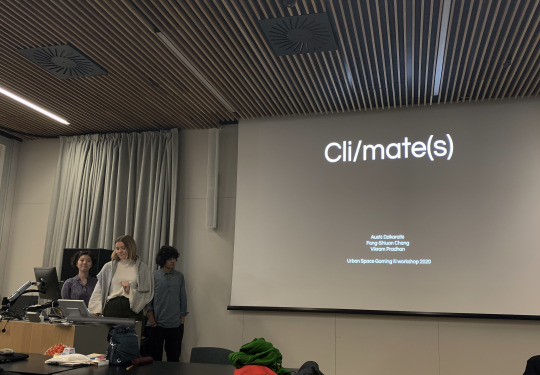

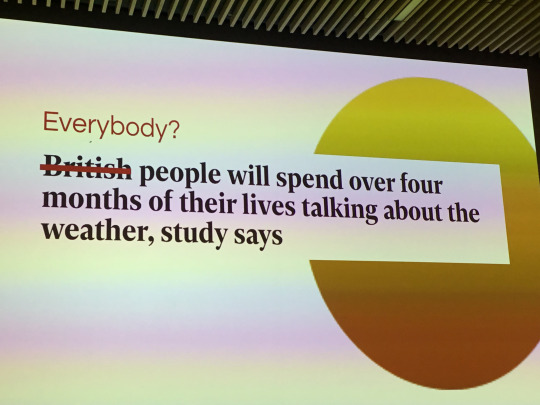







Group 7 / Austéja, Vikram and Fang Xuan “CLI/MATE/S”
The group focused on climate, weather and small talk. According to statistics, people in average spend four months of their lives talking about the weather. Weather is something that affects us massively. It influences our mood and how we interact with others. It has always been an important topic for everybody. Today, it is as important as ever. The group wanted to explore the theme and how people like to talk about it, share their feelings and opinions on it. With climate change in presence, this innocent topic becomes more serious than the usual weather small talk we are all used to. The group introduced an app which lets one select the weather for everybody, for the whole city. Selection process is gamified so that one can match different weathers with different moods - but one has to play carefully. The weather one chooses will affect everybody in the weather simulation.
1 note
·
View note
Photo









Group 6 / Goda, Christopher and Olga: SPEED BUGZ. Slow Down : )
First, the group discussed the concept of “escaping the game”: it started to think about a mental game where the objective is to avoid thinking about the game itself. The group introduced SPEED BUGZ, a concept for an Alternate Reality Game (an interactive networked narrative) which uses the real world as a platform. The game applies transmedia storytelling to deliver a story that may be altered by players' ideas or actions. The group then introduced a concept of Stigmergy: a mechanism of indirect coordination, through the environment, between agents or actions, which they utilised while creating the game concept. The key game element is Speed Bugz, soft and hard material bug-looking objects, which are, according to the group, passive, personalized, adaptive, customizable, collectable, symbolic and about community. The Speed Bugz utilizes elements of time & space, autonomous networks, self-reflection, alternative realities, relationships and mistakes (drawing strongly on concepts inherent in therapy) - all, according to the group, perfect features in a game concept.
1 note
·
View note
Photo
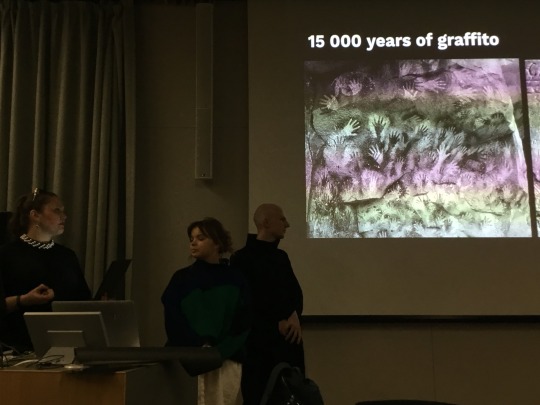


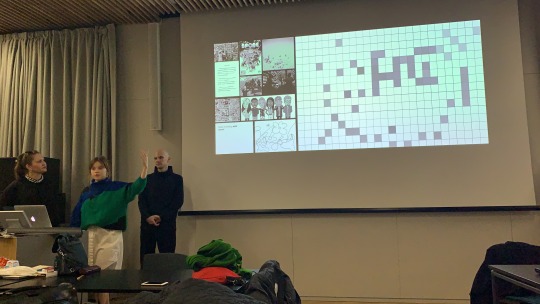






Group 5 / Ignas, Kristel and Helmi: “METROART”
The group started by giving a historical contextual timeline: the human species has created 15 000 years of graffito, 5000 years of advertising and 53 years of graffiti. The group´s goal is to give people an ownership of public space, to make metro commuters feel more active and connected and leave their mark in the surroundings. Also, this would be a way to make the city look a bit like its inhabitants. The group presented METROART, a game which allows people to use screens in the metro cars for creating and interacting. One can plug in and leave a mark. The results will be shown on a wall of art at the stations and on the web. There are over 750 advertising screens in the Helsinki city metro system, a part of which could be used for the game. There were lots of rich ethical considerations presented by the possibilities of this concept.
0 notes
Photo









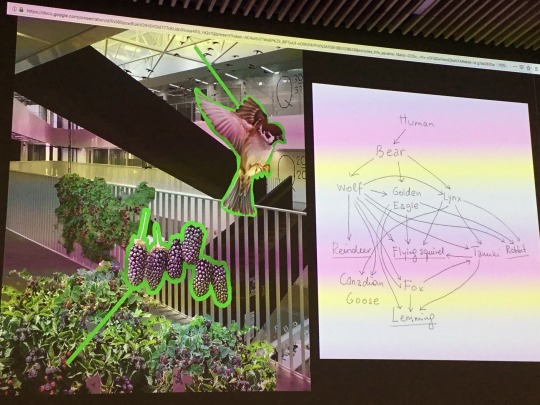
Group 4 / Elena, Beate and Kawachi: “RINNE: Towards coexistence with multi-species” presented a concept for a game that engages/connects people in the context of urban or public space. The group raised the questions “´Public´ for whom? Only for human beings?” Humans cannot live without other species. That is why the group addressed the project goal as “towards the world of coexistence with multi-species” which derived a design question: “how can a game engage people to catalyze reflection and raise awareness of human-centeredness and coexistence with other species?” In the presentation, a concept of Anthropocen was introduced, which refers to a geological epoch when humans started to have impact on the eco systems as well a concept of Holobiont, which means to raise awareness of human-centeredness and reconnecting with nature. What if one was an animal? The group ended up presenting “Rinne”, an AR role-playing game where gamers play as local animals for survival in the future city. The game is targeted to young people living in the city centrum, especially with passion about climate change or games. In the game, one can choose an animal, and reincarnate into that animal with a special costume and AR glasses. Finally, the group presented an impressive video, where one of the group members, Elena, played a ‘flying squirrel’. This focus on animals and shared space, was an interesting variation on theme and response to the brief.
0 notes
Photo









Group 2 / Evelina, Ali and Yee: “VANHA SUOMI (Old Finland)”
The group pointed out that traditional stories and myths are being forgotten, people are too preoccupied with the daily drill and are not aware of their surroundings. The main idea of the game “Vanha Suomi” is an intervention on people’s daily routines that draw people’s attention to the surroundings, as well as to reinterpret and visualize the historical stories in a playful, storytelling manner and to invite people to interact with the creatures from the myths. The game, which will be played without phones, raises cultural awareness of local society and increases (also) outsiders´ knowledge. Target audience is passers-by, families, tourists, people motivated by the satisfaction of hunting treasures, in short, all people looking for meaningful entertainment during darker periods of time (autumn-winter evenings).
1 note
·
View note
Photo






Group 1 / Emilis, Rebekka and Alina: ¡ALBINGO!
The group wanted to make it socially acceptable for students, teachers and other school staff to communicate to each other in a fun non-serious way, on personal, cultural and social, rather than academic or professional levels. ¡ALBINGO! is based on the already known game Bingo. Why bingo? It’s a famous game known and played all around the world, including Finland. All generations play as it bonds people together in a social setting. Instead of relying on pure luck, one has to step out of one´s comfort zone to win. One has to collect points by finishing a row of tasks and then spend one´s points on some fine goodies. One has to encounter people, other students, teachers or school staff. One has to ask the question ¡ALBINGO! generates in the game. There are eg. sticker puzzles, creative and physical activity tasks. To be able to complete a task one must touch phones with another player. Rewards are given upon successful completion.
0 notes
Text
Friday 7 February
This last day of the workshop was, long, very busy and a little frantic, as groups were finishing up and preparing their final presentations. Tarja showed some final presentation examples from previous workshops. Presentations started at 5 pm.
Group 1 / Emilis, Rebekka and Alina: ¡ALBINGO! The group wanted to make it socially acceptable for students, teachers and other school staff to communicate to each other in a fun non-serious way, on personal, cultural and social, rather than academic or professional levels. ¡ALBINGO! is based on the already known game Bingo. Why bingo? It’s a famous game known and played all around the world, including Finland. All generations play as it bonds people together in a social setting. Instead of relying on pure luck, one has to step out of one´s comfort zone to win. One has to collect points by finishing a row of tasks and then spend one´s points on some fine goodies. One has to encounter people, other students, teachers or school staff. One has to ask the question ¡ALBINGO! generates in the game. There are eg. sticker puzzles, creative and physical activity tasks. To be able to complete a task one must touch phones with another player. Rewards are given upon successful completion.
Group 2 / Evelina, Ali and Yee: “VANHA SUOMI (Old Finland)” The group pointed out that traditional stories and myths are being forgotten, people are too preoccupied with the daily drill and are not aware of their surroundings. The main idea of the game “Vanha Suomi” is an intervention on people’s daily routines that draw people’s attention to the surroundings, as well as to reinterpret and visualize the historical stories in a playful, storytelling manner and to invite people to interact with the creatures from the myths. The game, which will be played without phones, raises cultural awareness of local society and increases (also) outsiders´ knowledge. Target audience is passers-by, families, tourists, people motivated by the satisfaction of hunting treasures, in short, all people looking for meaningful entertainment during darker periods of time (autumn-winter evenings).
Group 4 / Elena, Beate and Kawachi: “RINNE: Towards coexistence with multi-species” presented a concept for a game that engages/connects people in the context of urban or public space. The group raised the questions “´Public´ for whom? Only for human beings?” Humans cannot live without other species. That is why the group addressed the project goal as “towards the world of coexistence with multi-species” which derived a design question: “how can a game engage people to catalyse reflection and raise awareness of human-centeredness and coexistence with other species?” In the presentation, a concept of Anthropocen was introduced, which refers to a geological epoch when humans started to have impact on the eco systems as well a concept of Holobiont, which means to raise awareness of human-centeredness and reconnecting with nature. What if one was an animal? The group ended up presenting “Rinne”, an AR role-playing game where gamers play as local animals for survival in the future city. The game is targeted to young people living in the city centrum, especially with passion about climate change or games. In the game, one can choose an animal, and reincarnate into that animal with a special costume and AR glasses. Finally, the group presented an impressive video, where one of the group members, Elena, played a ‘flying squirrel’. This focus on animals and shared space, was an interesting variation on theme and response to the brief.
Group 5 / Ignas, Kristel and Helmi: “METROART” The group started by giving a historical contextual timeline: the human species has created 15 000 years of graffito, 5000 years of advertising and 53 years of graffiti. The group´s goal is to give people an ownership of public space, to make metro commuters feel more active and connected and leave their mark in the surroundings. Also, this would be a way to make the city look a bit like its inhabitants. The group presented METROART, a game which allows people to use screens in the metro cars for creating and interacting. One can plug in and leave a mark. The results will be shown on a wall of art at the stations and on the web. There are over 750 advertising screens in the Helsinki city metro system, a part of which could be used for the game. There were lots of rich ethical considerations presented by the possibilities of this concept.
Group 6 / Goda, Christopher and Olga: SPEED BUGZ. Slow Down : ) First, the group discussed the concept of “escaping the game”: it started to think about a mental game where the objective is to avoid thinking about the game itself. The group introduced SPEED BUGZ, a concept for an Alternate Reality Game (an interactive networked narrative) which uses the real world as a platform. The game applies transmedia storytelling to deliver a story that may be altered by players' ideas or actions. The group then introduced a concept of Stigmergy: a mechanism of indirect coordination, through the environment, between agents or actions, which they utilised while creating the game concept. The key game element is Speed Bugz, soft and hard material bug-looking objects, which are, according to the group, passive, personalized, adaptive, customizable, collectable, symbolic and about community. The Speed Bugz utilizes elements of time & space, autonomous networks, self-reflection, alternative realities, relationships and mistakes (drawing strongly on concepts inherent in therapy) - all, according to the group, perfect features in a game concept.
Group 7 / Austéja, Vikram and Fang Xuan “CLI/MATE/S” The group focused on climate, weather and small talk. According to statistics, people in average spend four months of their lives talking about the weather. Weather is something that affects us massively. It influences our mood and how we interact with others. It has always been an important topic for everybody. Today, it is as important as ever. The group wanted to explore the theme and how people like to talk about it, share their feelings and opinions on it. With climate change in presence, this innocent topic becomes more serious than the usual weather small talk we are all used to. The group introduced an app which lets one select the weather for everybody, for the whole city. Selection process is gamified so that one can match different weathers with different moods - but one has to play carefully. The weather one chooses will affect everybody in the weather simulation.
Group 3 / Ada, Sylvia and Gintare: “THE PROJECT UNDERGROUND” This group asked to be the last in order to finish a video rendering. The presented concept raises awareness on whales. It is a participatory activist game in Helsinki metro stations where passengers will need to take action in saving a whale that is projected on a ceiling. Goal is to help the “virtual” whale to stay in the ‘ocean’. Metro passengers have about 5 minutes while waiting for the next train. People have to work together to press buttons to keep the whale afloat, they have to collaborate. The aim and goal of the game in addition to raising awareness on animal cruelty around and other environmental issues of the world are to make people work together to solve a situation, to make people aware of importance of their action, to bring a light on the importance of communication and cooperation while solving important issues and empower people to take action in urgent situations. The group showed at the end a very impressive video presentation of the concept.
All in all, the audience including all the tutors and the guest commentator Michail Galanakis, the urban space politics researcher from the Architecture Department, were impressed by the presented concepts. Considering the relatively short time spent on concept development, the results were successful both in addressing important issues and in communicating the core ideas in an intriguing, and in some case, in an outstanding way.
After the final presentations, as it was getting dark, it also started snowing. Big surprise when we saw a beautiful fresh carpet of snow around the buildings. First the tutors went to the shop to buy food at the K-Market, and drinks for the Farewell party in the Studio space of the Aalto Arts Design Factory building. Tutors Tarja, Wulf and Ausra started preparing the food and the snacks. Antti Hietaniemi, one of the tutors, was the VJ of the night and created a colourful slightly modern psychedelic ambient projection showcasing e.g. BA student work created during his motion media courses in the Visual Communication Design unit of the Media Department. Antti also provided the sound track for the party. At about 23:30 everyone left to go home or for the pub crawl in the city.
1 note
·
View note
Text
Thursday 6 February
We now changed to a new teaching room in the Business School of the Aalto University, the ‘gold’ cluster on the other end of the Väre building. The room was T003.
Since this was the National Sámi Culture Day in Finland, Tarja started the day with a presentation of a Finnish joik artist Wimme Saari.
Projects were discussed. We had to leave our room in the afternoon for a couple of hours due to a double booking. Students then worked in the open area in between in the common ground.
In the evening half of the students and the tutor Sam went to the ‘cold-water’ swimming pool and sauna Allas Pool at the harbour of the main Market Place. There was a freezing cold wind outside, so this cold water swimming is for the brave souls. All tutors, except Sam, walked back to the centre along the Esplanade to the Savoy Theatre. Tarja had arranged tickets for the tutors for a contemporary joik concert. Two Norwegian acts performed, the Vassvik duo from the Arctic Coast gave the most impressive performance. After that the main act Elle Márjá gave with her band an interesting performance, mixing film clips and all kinds of media with her contemporary joik. A political message is central to her performance talking about the plight of the suppressed Sámi people and their lands, threatened by global energy multinationals, forestation, and sea oil and gas drilling companies, threatening their way of life.
1 note
·
View note

































